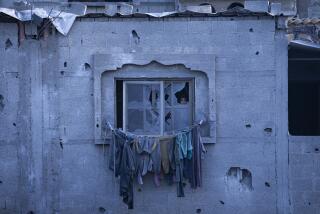Poisoning a City Is Harder Than in Our Nightmares
- Share via
Osama bin Laden, the prime suspect in masterminding the terrorist attacks on the U.S., has never denied his interest in acquiring nuclear, biological and chemical weapons--although that doesn’t appear to be the direction in which he is headed.
In a television interview in 1999, he said, “To seek to possess the weapons that could counter those of the infidels is a religious duty.” Indeed, in court documents unsealed in 1998 in connection with the trial of the bombers of the U.S. embassies in Kenya and Tanzania, U.S. prosecutors charged that Bin Laden has made efforts to obtain the components of chemical weapons as early as 1993. One of his disciples, Ahmed Ressam, who was sentenced to 140 years in prison for his role in the plot to bomb the Los Angeles International Airport, testified in court that he and others were taught to use cyanide, including how to feed it into air ducts in buildings to kill large number of people.
In an affidavit filed recently by the U.S. Justice Department to extradite two members of Bin Laden’s Al Queda terrorist organization from Britain, evidence was presented of at least two attempts by the group to buy enriched uranium to make a nuclear weapon.
The recent attacks on U.S. soil amply demonstrate that America’s strategic deterrence has failed. Indeed, in the wake of the horrific attacks on the U.S., many have concluded that the use of weapons of mass destruction may be imminent.
On Sept. 11, the FAA temporarily grounded all crop-dusters for fear they could be used to spray chemical or biological agents. Sen. Bob Graham (D-Fla.), chairman of the Senate’s Select Committee on Intelligence, said that the CIA told him that “there were other acts of terrorism in the U.S. and elsewhere that were part of this plan. Not necessarily hijacking another airliner but maybe putting a chemical in a city’s water system.” On Sept. 18, the Senate Press Gallery told reporters they would be given gas masks as a precaution.
Yet on closer examination it appears that Bin Laden so far has opted for using “conventional” weaponry in his war on the U.S.
There are numerous reasons for this choice. First, while it is relatively easy to produce chemical and biological agents, dispersing them effectively requires a high level of technical proficiency. Recall that early Iraqi attempts to conduct chemical warfare in its war with Iran were not only ineffective, they ended up contaminating Iraqi soldiers themselves.
The Japanese terrorist group Aum Shinrikyo, also known as the Aum Supreme Truth, simultaneously released the chemical nerve agent sarin on several Tokyo subway trains in 1995. It was able to kill just 12 people and injure several thousand--most of the latter from the ensuing panic--because of problems with the agent as well as its method of dissemination. The group attempted to disperse anthrax and botulinum toxin at least five times without success, despite the fact that the group had at its disposal chemists and molecular biologists as well as modern laboratories.
Similarly, attempts to poison the population of a U.S. city by contaminating its water supplies with chemical or biological agents would likely fail.
Palestinian terrorists have tried the chemical route against the Israel national water carrier without success. Generally, chlorinated water supplies inactivate toxins within 20 minutes. Even fresh water naturally inactivates botulinum toxin within three to six days.
The point is that Bin Laden’s method of attack provided higher confidence in the results.
Equally important, the attacks on the World Trade Center and the Pentagon indicate that Bin Laden sought to achieve the following objectives:
First, inflict mass casualties to signal the ruthlessness of the attackers and frighten and intimidate the United States.
Second, cause mass destruction, allowing Bin Laden show to his followers as well as enemies that U.S. power would turn into rubble when confronted by Islam’s warriors.
Third, martyrdom; by opting for a suicide mission, Bin Laden has signaled that he is undeterrable. “We will win because we are ready to go all the way and pay any price,” is the unmistakable message.
Fourth, destroy the symbols of America’s might; the attack was aimed at the centers of the U.S. military and economic power.
While chemical and biological attacks could certainly cause mass killings and could even be pinpointed against a building such as the Pentagon, such attacks would not provide the spectacular destruction that Bin Laden sought. Moreover, biological and chemical warfare does not lend itself to martyrdom the way a fiery crash of a plane does.
Thus, if these criteria continue to hold, the greatest care should be given to protecting the U.S. government’s nuclear, biological and chemical facilities and laboratories from a suicide attack either from the air or the ground.
More to Read
Sign up for Essential California
The most important California stories and recommendations in your inbox every morning.
You may occasionally receive promotional content from the Los Angeles Times.













